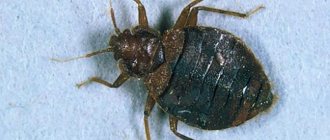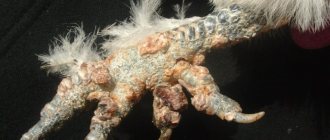What is tularemia?
Tularemia is an infectious disease. Both humans and animals can become infected. Zooanthropotic infection has a natural focality, and statistical data make it possible to identify regions with a high risk of outbreaks.
Francisella tularensis colony
Tularemia is caused by gram-negative bacteria, the peculiarity of which is polymorphism. Pathogens can exist in different organisms that differ in their structure. This is what allows bacteria to infect organisms in different life cycles.
Francisella tularensis bacteria was first mentioned in the state of California when scientists Chapin and McCoy discovered the causative agent of infection in ground squirrels. The causative agent of tularemia was assigned the second class of pathogenicity. Francisella tularensis is assessed as a pathogen that causes disease but poses little risk to humans, animals and their environment.
The causative agent of tularemia dies 10 minutes after heating to 60 degrees. In boiling water, the bacterium dies instantly.
Symptoms:
- a sharp increase in body temperature (up to 40 degrees);
- headache;
- muscle aches;
- dizziness, confusion;
- decreased appetite;
- nausea, vomiting;
- nosebleeds;
- enlarged lymph nodes.
The incubation period does not exceed three weeks. Typically, signs of the disease appear 3-5 days after infection.
Live healthy! Tularemia is a danger from rodents. (07/24/2017)
Brief essay
Vaccination is not mandatory according to the approved vaccination schedule. And, in fact, most of the population are not at all familiar with this disease, its causes and consequences.
This disease was previously called "rodent disease", "minor plague" and "rabbit fever". People accurately noted its appearance with the presence of small rodents and found some similarities with the well-known bubonic plague. Speculation and conjecture turned out to be not so groundless - scientists discovered the cause of the disease - the bacterium Francisella tularensis.
The carriers in nature, indeed, are rodents of small breeds. A person becomes infected through contact through poor heat treatment of meat, contaminated water, mosquito bites and when animal waste products come into contact with food. That is why tularemia poses the greatest threat to residents of rural areas, as well as to workers on livestock farms.
Tularemia is an acute infectious disease of focal distribution, which is prone to mass destruction of the population of adjacent territories. History has not seen widespread epidemics because tularemia is extremely difficult to transmit.
At the turn of the 1990s and 2000s, in Russia, no more than 300 people were identified as having been infected, and this was due to the fact that the authorities canceled mandatory vaccination for what they thought was a minor infection.
In almost 100% of cases, this disease is sensitive to treatment with standard broad-spectrum antibiotics (macrolides, fluoroquinolones), but the recovery process can take from 1 to 3 months.
Perhaps the main symptom of tularemia is enlarged lymph nodes, which are called bubo in medical terms. Inflammation of the bubo disappears after 3 months after the start of active therapy.
No more than half a percent of the total number of infected people were registered, but tularemia is dangerous due to its further complications such as lobar pneumonia, encephalopathy, acute delirious psychosis and multiple lesions of the joints of the arms and legs. Tularemia is characterized by a transition to a chronic course after active antibiotic therapy. This can happen several months after treatment, and if this process is allowed, the chronic course will worsen, which will lead to severe damage to the membranes of the brain and spinal cord. However, as already mentioned, such cases are rare.
Characteristics of the tularemia vaccine
Today, the vaccine against tularemia is an extract of pathogenic, but not virulent, that is, those that are capable of infecting, bacteria. The vaccine is stored strictly in a dry and dark place in an ampoule, and right before injection it is diluted in distilled water.
Popular When is the best time to get vaccinated to avoid getting scarlet fever?
Before direct injection, a so-called serology test should be performed in order to determine the presence of active immunity against this pathogen. This is done by applying a preparation containing tularemin to the skin treated with a disinfectant and making a small puncture with a needle to draw blood from the finger. If hyperemia and slight swelling appear at the puncture site, this will indicate that the cells of the immune system are interacting with the pathogen, beginning to overcome it, and in this situation, vaccination is not necessary.
The vaccination process itself is similar in methodology. Apply 2 drops of the substance to the inner surface of the upper third of the forearm at a distance of 3 cm, and then a parallel shallow incision is made with a scarifier. It is important not to cut too deeply, but only to small droplets of blood. Vaccination can be carried out in conjunction with other vaccinations, or at the same time, if you need to be vaccinated against plague or brucellosis.
Active, lasting immunity will be formed after a month and will be valid for the next five years. After this, revaccination should be carried out.
Possible body reactions
Considering that the vaccine against tularemia contains, although not virulent, but still pathogenic microorganisms Francisella tularensis, the body's reaction to its administration should be typical for such cases. Often, this manifests itself in this way:
- Hyperemia, myxedema at the injection site on days 3-5
- Formation of small papules that will eventually turn into crusts
- General malaise
- Low-grade fever (37.5 – 38 °C) up to 4 days
- Peripheral lymphadenopathy
Vaccination and its side effects do not pose any danger; on the contrary, this indicates successful vaccination and the beginning of the formation of cellular immunity in the body. If these reactions are not observed within a week, revaccination should be carried out after 1 month.
Along with this, sometimes much more dangerous effects occur:
- Persistent fever (40 °C or more)
- Anaphylaxis
- Inflammation of peripheral lymph nodes
The possibility of side effects occurring is extremely low, however, in order to exclude such reactions, experts recommend being under the strict supervision of the attending physician for an hour or two, who, if the above described occurs, will be able to provide emergency assistance as quickly as possible.
It is worth noting that a severe reaction to vaccination is observed during repeated vaccination and in people who have had tularemia. That is why, an absolute contraindication to vaccination against tularemia is the presence of active humoral antibodies, which are formed as a result of the repeated entry of a foreign agent, such as bacteria, into the body. There are recommendations from the World Health Organization, according to which vaccination against tularemia in children under the age of seven years is not carried out under any circumstances.
Popular Infertility and disease are not scary with cervical cancer vaccination
Absolute contraindications:
- Pregnancy and/or breastfeeding
- Acute diseases, exacerbation of existing ones
- Asthmatic status
- History of any antitumor therapy
- Oncology
- HIV status
If there is such a possibility, then vaccination is carried out a little later, or is excluded completely; all this correlates with the type of contraindications and the epidemiological situation in the territory.
Should I be vaccinated against tularemia?
Vaccination against tularemia is not included in the mandatory vaccination schedule. Therefore, many people learn about this vaccine by accident. In the first year of life, the child receives the bulk of vaccinations, which form the foundation for future immunity. But pediatricians do not suggest that parents be vaccinated against tularemia unless the family lives in an unfavorable region and does not have a high risk of infection.
Whether to vaccinate or not is a personal matter for each person. No one has the right to force a patient to get vaccinated. At the same time, the doctor always warns the patient about complications that may arise due to refusal to vaccinate. Vaccination against tularemia is recommended for epidemic indications. The schedule and timing of vaccination should be discussed with your doctor individually.
The causative agents of tularemia are transmitted from animals to humans. The infection is transmitted by insects or enters the bloodstream through direct contact with the biological material of an infected animal (for example, during butchering or cooking meat). Every person has a chance of becoming infected. To protect yourself, it is better to get vaccinated.
What kind of disease is tularemia?
Tularemia
bacteria
are usually different types of rodents
isolated cases
Why is tularemia considered a particularly dangerous infection?
Tularemia is considered a dangerous infectious disease for the following reasons:
- Risk of death and disease consequences.
The causative agent of tularemia can affect a variety of organs and tissues.
Some forms of the disease ( generalized, pulmonary
) lead to disruptions in the functioning of vital organs, creating a threat to life.
Local forms ( sore throat, eye damage
) are fraught with complications and consequences of the disease that will not disappear after recovery. For example, the ocular form of tularemia sometimes leads to blindness and disability. - Difficulties in prevention.
Prevention of tularemia requires surveillance of numerous animal species in the wild, which presents challenges. General vaccination is usually not necessary, since the risk of encountering the pathogen is very small, and the vaccine has side effects. - Difficulties in treatment.
The causative agent of tularemia is resistant to many antibiotics.
Once in the body, it is located inside living cells, which presents additional difficulties for treatment ( limited choice of drugs, longer course of treatment
). - Difficulties in diagnosis.
The first symptoms of tularemia are similar to those of other, more common infectious diseases. This often causes a delay in starting proper treatment. - High human sensitivity.
People who do not live in areas where tularemia is common are generally not vaccinated against the disease. At the same time, the human body is very susceptible to the causative agent of tularemia, and there is almost no chance that the immune system will independently cope with the bacterium after it enters the body.
Where does tularemia come from (etiology)?
Francisella tularensis muskrats, mice, voles, etc.
bites of blood-sucking insects
that have previously bitten an infected animal
How does the disease develop in humans (pathogenesis)?
With tularemia, the pathogen goes through the following stages in the body:
- Entry into the body can occur in various ways. Most often, the pathogen penetrates through the skin or mucous membranes ( conjunctiva, tonsils
).
Somewhat less often, it enters the body with food or dust ( in inhaled air
).
There is no fundamental difference, since it is attached to the epithelium of internal organs ( lungs or intestines
). - Having penetrated the cells of the mucous membrane, the bacterium begins to multiply. This, in turn, explains the local inflammatory process, which often ends in necrosis ( death of a tissue area
). Ulcers may form on the skin and mucous membrane at the site of penetration. - From the primary focus in the tissues, the bacterium enters the lymphatic vessels and through them reaches the lymph node. Here are cells that normally should destroy pathogens. However, the causative agent of tularemia is resistant to their enzymes. Typically, the first lymph node that the bacterium reaches becomes greatly enlarged and inflamed. Here specific granulomas are formed, and the lymph node gradually melts. Such a focus is called a primary bubo.
- Active reproduction of bacteria in the primary bubo and their partial death leads to the release of a toxin. This explains the appearance of common symptoms of intoxication - headache, muscle pain and joint pain, fever.
- From the primary bubo the pathogen can ( but not always
) enter the blood.
In this case, it quickly spreads throughout the body. lungs, liver, spleen
are affected . This form of the disease is called generalized. The lymph nodes where the pathogen enters through the blood are called secondary buboes. They are not so greatly enlarged and rarely undergo purulent melting. - If the bacterium does not enter the blood, the pathological process does not spread. Then the symptoms and pathological changes are localized in one area. With angina, these are changes at the level of the mucous membrane of the tonsils. In pneumonia, the bacterium partially destroys the lung tissue and penetrates the lymph nodes at the roots of the lungs. In the abdominal ( intestinal
) form, the mesenteric (
mesenteric
) lymph nodes become inflamed. In the last two cases, the primary bubo will not be noticeable, since it will not be located superficially under the skin, but between the internal organs.
Refusal of vaccination against tularemia
Persons living in unfavorable epidemic areas are recommended to be vaccinated against tularemia. However, a person can refuse vaccination, as well as any medical intervention.
Parents are increasingly faced with the fact that educational institutions offer to vaccinate their children against tularemia. Only the parent or legal representative of the child decides whether to take the vaccine or not. If a decision is made to refuse immunization, the corresponding document is filled out.
Expert opinion
Irina Katykova
Pediatrician, pediatric neurologist
Ask a Question
Do you still have questions about your child's health? Ask them right here on the website and we will definitely answer!
How do you feel about mandatory vaccination?
- Positively, it prevents many diseases. 61%, 2389 votes
2389 votes 61%2389 votes - 61% of all votes
- Negatively, these are all government schemes to make it easier to manage us. 26%, 1021 votes
1021 votes 26%
1021 votes - 26% of all votes
- Neutral, I don’t think it has any effect on my health. 13%, 525 votes
525 votes 13%
525 votes - 13% of all votes
Total votes: 3935
Votes: 3914
January 17, 2018
×
You or from your IP have already voted.
Indications for vaccination
The tularemia vaccine is given if a person lives in a region with a high risk of spreading the infection. According to outbreak observations, the disease is spreading in Asia, Europe, North America, France, Austria, and Germany.
The Sanitary and Epidemiological Supervision Service recommends vaccination against tularemia for the following groups of people:
- working in laboratories and in contact with cells of tularemia pathogens;
- participants in disinfection and rescue operations carried out in connection with the spread of tularemia;
- living in a region where an outbreak of the disease has been reported;
- farm workers, hunters, veterinarians.
Specific prevention, how long does the vaccine last?
Before vaccination, the doctor will check whether the patient has immunity against tularemia. A serological test is carried out, the vaccine is administered only if the test result is negative.
Despite the fact that the vaccine against tularemia is live, the patient does not risk becoming infected, since the bacteria are weakened. Immediately after administration of the drug, cellular immunity begins to work, responsible for fighting infection. The product is effective after 20 or 30 days. The immunity developed after vaccination lasts for five years. After this, revaccination is recommended.
Is vaccination mandatory and who should get it?
Antitularemia vaccination is included in the calendar for epidemic indications. It is not mandatory for everyone, but certain categories of people should be protected from the disease.
Relevant services determine the categories of people who need immunization. As a rule, the decisive factors are the type of activity and the region of residence. Vaccination against tularemia is required:
- workers of laboratories where tularemia bacteria are studied and cultivated;
- participants in disinfection activities in epidemiologically unfavorable areas;
- residents of infected areas;
- workers of farms and other forms of livestock farming in areas unfavorable for tularemia;
- vacationers in dangerous regions.
Vaccination may be an emergency when an epidemic begins. Depending on the situation, the categories of vaccinated persons may change. For example, those who arrived in a dangerous area to work (usually rotation workers) are urgently vaccinated.
Tularemia is a disease that few people know about. But those who have had this infection certainly would not want to encounter it again. Vaccination is not obligatory, whether to do it or not, everyone decides for themselves, but it is better to take preventive measures than to deal with the consequences later. After all, sometimes the most harmless disease can have side effects, which will take a long and difficult time to get rid of, and sometimes even impossible completely. Thus, untreated buboes look extremely unattractive, and the disease sometimes takes on a chronic form, flaring up with renewed vigor when the immune system is weakened. Therefore, it is worth thinking about immunization, especially if the patient belongs to “risk groups”. In this case there should be no doubt.
Contraindications
Vaccination against tularemia is not given during periods of exacerbation of chronic diseases. Immunization can be carried out after the acute process has resolved.
Contraindications for vaccination against tularemia:
- children under 7 years of age;
- pregnancy;
- breastfeeding period;
- oncological diseases;
- blood diseases;
- use of blood products in the next 3-4 months;
- bronchial asthma;
- tendency to allergic manifestations;
- immunodeficiency states;
- some nervous system disorders.
The tularemia vaccine is not given to a person who has previously had tularemia.
Choose a tularemia vaccine
Patients are interested in whether they can choose to be vaccinated against tularemia. Many are willing to pay for an imported drug. However, there is not much choice. Vaccination is performed with the same drug for everyone. Live tularemia vaccine is used for immunization. The drug is produced by JSC NPO Microgen.
The company producing the tularemia vaccine is a key Russian manufacturer of vaccines for seasonal influenza prevention. It is the only one in the country that produces botulinum toxins type A, which are used in neurological practice, as well as cosmetology. Produces medicinal preparations - bacteriophages - produces more than 19 types of drugs of this type.
In America, their own vaccine, Tulivax, is used for immunization against tularemia. But it is not used in domestic medicine. Therefore, it will not be possible to supply imported vaccinations in Russia.
Timing and rules of vaccination
The vaccine is given in medical institutions that have permission to administer the vaccine. The patient is first examined by a doctor to rule out possible contraindications. The vaccine is given subcutaneously or subcutaneously. Typically the area of the forearm is chosen for injection.
The vaccine is given once. Revaccination is not carried out. Immediately after the vaccine is administered, the patient is observed by a doctor for 20-30 minutes. This is necessary in order to exclude or promptly prevent an allergic reaction. A test must be performed 2 weeks after vaccination. The result will allow you to assess the quality of the immune response. In the absence of antibodies against tularemia and a negative test reaction, the injection is given again.
Vaccination against tularemia for children
Since the bulk of vaccinations are given to a child in the first year of life, parents are interested in the tularemia vaccine. Moms and dads, trying to protect their baby, learn about the timing and procedure for immunization of children. However, WHO does not recommend vaccination against tularemia before one year, per year, or even at 5 years. The vaccine manufacturer indicates in the instructions that the vaccine is contraindicated for children under 7 years of age. In field-type outbreaks, the vaccine is given to children from 14 years of age.
Vaccination provides lasting immunity 30 days after administration of the drug. The protective reaction lasts for 5 years. If, after 5 years from the date of vaccination, the patient still has indications, then the vaccine is given again.
Live tularemia vaccine
Vaccine for the prevention of tularemia
Active substance
– vaccine for the prevention of tularemia
Release form, composition and packaging
Lyophilisate for preparing a suspension for intradermal administration
and cutaneous scarification application in the form of a porous mass of white color with a yellow tint.
| 0.1 ml | |
| vaccine for the prevention of tularemia (one dose for cutaneous scarification is 0.1 ml and contains (2.0±0.5)•108 live microbial cells, a dose for intradermal administration is 0.1 ml and contains (1.0±0.1)•107 live microbial cells) | 1 dose |
Excipients: sucrose – 0.0033 g, sodium glutamate monohydrate – 0.00495 g, thiourea – 0.00165 g, gelatin – 0.0033 g.
Solvent composition:
water d/i.
15 -50 cutaneous doses – ampoules (5) complete with solvent 5 ml amp. 5 pieces. - cardboard packs.
pharmachologic effect
The vaccine ensures the development of immunity lasting up to 5 years 20-30 days after vaccination.
Indications
Prevention of tularemia from 7 years of age (from 14 years of age - in field-type foci).
The population living in territories enzootic for tularemia, as well as persons arriving in these territories performing the following work, are subject to vaccination:
- agricultural;
- irrigation;
- construction;
- other work on excavation and movement of soil;
- procurement;
- fishing;
- geological;
- exploratory;
- expeditionary;
- deratization and disinfestation;
- for logging, clearing and landscaping of forests, health and recreation areas for the population.
Contraindications
- history of tularemia;
- positive serological or skin allergic reaction to tularemia;
- acute infectious and non-infectious diseases, chronic diseases in the acute stage - vaccinations are carried out no earlier than 1 month after recovery from remission);
- primary and secondary immunodeficiencies. When treating with steroids, antimetabolites, chemotherapy and radiotherapy, vaccinations are carried out no earlier than 6 months after the end of treatment;
- systemic connective tissue diseases;
- malignant neoplasms and malignant blood diseases;
- common recurrent skin diseases;
- allergic diseases (bronchial asthma, anaphylactic shock, history of angioedema);
- pregnancy and lactation period.
Dosage
Vaccination is carried out once, either cutaneously or intradermally. Revaccination is carried out according to indications after 5 years with the same dose.
In order to identify contraindications, the doctor (paramedic) on the day of vaccination conducts a survey and examination of the vaccinated person with mandatory thermometry. At temperatures above 37°C, vaccination is postponed. If necessary, a laboratory examination is carried out.
Before each vaccination, the vaccine recipient is required to determine the presence of specific immunity using one of the serological or skin-allergic reactions. Persons with a negative reaction are subject to vaccination.
The vaccination performed is registered in the established registration forms, indicating the name of the drug, date of vaccination, dose, name of the manufacturer of the drug, batch number, reaction to the vaccination.
Vaccination by cutaneous method:
The dry vaccine is diluted with water for injection, included with the drug, at the rate of 0.1 ml per dose. The ampoule is shaken for 3 minutes until a homogeneous suspension is formed.
The grafting is carried out on the outer surface of the middle third of the shoulder. Before vaccination, the skin is treated with alcohol or a mixture of alcohol and ether; the use of other disinfectants is not allowed.
After the alcohol and ether have evaporated, one drop of the diluted vaccine is applied to the treated area of skin with a sterile eye pipette in two places at a distance of 30-40 mm from each other.
The skin of the shoulder is slightly stretched and with a sterile scarifier (vaccination pen), 2 parallel cuts 10 mm long are made through each applied drop of vaccine.
The notches should not bleed; blood should appear only in the form of small dewdrops. Using the flat side of a smallpox vaccination feather, rub the vaccine into the incisions for 30 seconds and allow to dry for 5-10 minutes.
Vaccination by intradermal method:
For intradermal needle-free administration, the vaccine is diluted in the same way as for skin scarification. Then, using a sterile syringe, 1 ml is transferred into a sterile injector bottle, to which 19 ml of sodium chloride injection solution 0.9% is added.
20 ml of the resulting suspension contains 200 doses of vaccine for intradermal administration. The vaccine injection site is pre-treated with alcohol or a mixture of alcohol and ether.
The vaccine is administered intradermally in a volume of 0.1 ml into the outer surface of the middle third of the shoulder according to the instructions for use of the BI-ZM injector with the anti-infective protector PPI-2 in a mode designed for intradermal administration.
Precautions for use.
It is strictly forbidden to administer the vaccine diluted for cutaneous scarification application intradermally!
A vaccine whose packaging is damaged, has altered physical properties (foreign impurities, insoluble flakes), has expired, or has not been stored in accordance with the storage conditions cannot be used.
The opening of the ampoules and the procedure for administering the drug are carried out in strict compliance with the rules of asepsis and antiseptics. The diluted vaccine, stored aseptically, can be used within 2 hours.
Considering the possibility of developing anaphylactic shock in certain highly sensitive individuals, the vaccinated person should be under medical supervision for at least 30 minutes. Vaccination sites must be provided with anti-shock therapy.
A local reaction during cutaneous vaccination should develop in all vaccinated people. At the site of the incisions, from 4-5 days, and in some vaccinated people - at a later date (up to 10 days) - hyperemia and swelling with a diameter of up to 15 mm develops. Along the notches, vesicles the size of millet grains may appear.
From 10-15 days a crust forms at the vaccination site, local phenomena subside, and after the crust separates, a scar remains on the skin. Sometimes there may be a slight short-term enlargement and tenderness of the regional lymph nodes.
If the result is negative, only slight redness is noted along the cuts for 1-2 days.
With the intradermal route of administration, a local reaction lasting up to 9 days is characterized by moderate hyperemia and skin infiltration with a diameter of up to 40 mm, and rarely enlarged regional lymph nodes.
The general reaction occurs in isolated cases from 3-4 days and is expressed by malaise, headache, and less often – a short-term increase in temperature to 38°C. These phenomena disappear after 2-3 days.
It is extremely rare for vaccinated people to experience general and local allergic reactions in the third or fourth week after vaccination.
In persons who have previously had tularemia or have been revaccinated, general and local reactions to the vaccine develop more rapidly. In this case, the extinction of vaccination reactions occurs faster than in those initially vaccinated.
The inoculability of the vaccine when applied to the skin is checked after 5-7 days, and if there is no skin reaction, it is checked again on days 12-15. The results of intradermal vaccination are assessed 4-5 days after vaccination.
A positive reaction is considered to be the presence of hyperemia and infiltrate with a diameter of at least 5 mm. Persons who do not have a positive vaccination result are subject to re-vaccination 30 days after determining the presence of specific immunity.
Overdose
Symptoms of overdose and measures to assist in case of overdose have not been established.
Drug interactions
Simultaneous cutaneous vaccination of adults with live vaccines against tularemia, brucellosis and plague (in different parts of the body) is allowed.
special instructions
Impact on the ability to drive vehicles and operate machinery
No information available.
Special precautions when disposing of unused medicinal products.
Ampoules with unused vaccine are inactivated by boiling for 30 minutes, after which they are disposed of in accordance with SanPiN 2.1.7.728-99 “Rules for the collection, storage and disposal of waste from medical institutions.”
Pregnancy and lactation
The use of the drug is contraindicated.
Use in childhood
Children from 7 years of age are vaccinated
Conditions for dispensing from pharmacies
For medical and preventive institutions.
Storage conditions and periods
Source: https://health.mail.ru/drug/vaktsina_tulyaremiynaya_zhivaya/
Indications of the drug Live tularemia vaccine
Prevention of tularemia from 7 years of age (from 14 years of age - in field-type foci).
The population living in territories enzootic for tularemia, as well as persons arriving in these territories performing the following work, are subject to vaccination:
- agricultural;
- irrigation;
- construction;
- other work on excavation and movement of soil;
- procurement;
- fishing;
- geological;
- exploratory;
- expeditionary;
- deratization and disinfestation;
- for logging, clearing and landscaping of forests, health and recreation areas for the population.
Dosage regimen
Vaccination is carried out once, either cutaneously or intradermally. Revaccination is carried out according to indications after 5 years with the same dose.
In order to identify contraindications, the doctor (paramedic) on the day of vaccination conducts a survey and examination of the vaccinated person with mandatory thermometry. At temperatures above 37°C, vaccination is postponed. If necessary, a laboratory examination is carried out.
Before each vaccination, the vaccine recipient is required to determine the presence of specific immunity using one of the serological or skin-allergic reactions. Persons with a negative reaction are subject to vaccination.
The vaccination performed is registered in the established registration forms, indicating the name of the drug, date of vaccination, dose, name of the manufacturer of the drug, batch number, reaction to the vaccination.
Vaccination by cutaneous method:
The dry vaccine is diluted with water for injection, included with the drug, at the rate of 0.1 ml per dose. The ampoule is shaken for 3 minutes until a homogeneous suspension is formed.
The grafting is carried out on the outer surface of the middle third of the shoulder. Before vaccination, the skin is treated with alcohol or a mixture of alcohol and ether; the use of other disinfectants is not allowed.
After the alcohol and ether have evaporated, one drop of the diluted vaccine is applied to the treated area of skin with a sterile eye pipette in two places at a distance of 30-40 mm from each other.
The skin of the shoulder is slightly stretched and with a sterile scarifier (vaccination pen), 2 parallel cuts 10 mm long are made through each applied drop of vaccine.
The notches should not bleed; blood should appear only in the form of small dewdrops. Using the flat side of a smallpox vaccination feather, rub the vaccine into the incisions for 30 seconds and allow to dry for 5-10 minutes.
Vaccination by intradermal method:
For intradermal needle-free administration, the vaccine is diluted in the same way as for skin scarification. Then, using a sterile syringe, 1 ml is transferred into a sterile injector bottle, to which 19 ml of sodium chloride injection solution 0.9% is added.
20 ml of the resulting suspension contains 200 doses of vaccine for intradermal administration. The vaccine injection site is pre-treated with alcohol or a mixture of alcohol and ether.
The vaccine is administered intradermally in a volume of 0.1 ml into the outer surface of the middle third of the shoulder according to the instructions for use of the BI-ZM injector with the anti-infective protector PPI-2 in a mode designed for intradermal administration.
Precautions for use.
It is strictly forbidden to administer the vaccine diluted for cutaneous scarification application intradermally!
A vaccine whose packaging is damaged, has altered physical properties (foreign impurities, insoluble flakes), has expired, or has not been stored in accordance with the storage conditions cannot be used.
The opening of the ampoules and the procedure for administering the drug are carried out in strict compliance with the rules of asepsis and antiseptics. The diluted vaccine, stored aseptically, can be used within 2 hours.
Considering the possibility of developing anaphylactic shock in certain highly sensitive individuals, the vaccinated person should be under medical supervision for at least 30 minutes. Vaccination sites must be provided with anti-shock therapy.
Side effect
A local reaction during cutaneous vaccination should develop in all vaccinated people. At the site of the incisions, from 4-5 days, and in some vaccinated people - at a later date (up to 10 days) - hyperemia and swelling with a diameter of up to 15 mm develops. Along the notches, vesicles the size of millet grains may appear.
From 10-15 days a crust forms at the vaccination site, local phenomena subside, and after the crust separates, a scar remains on the skin. Sometimes there may be a slight short-term enlargement and tenderness of the regional lymph nodes.
If the result is negative, only slight redness is noted along the cuts for 1-2 days.
With the intradermal route of administration, a local reaction lasting up to 9 days is characterized by moderate hyperemia and skin infiltration with a diameter of up to 40 mm, and rarely enlarged regional lymph nodes.
The general reaction occurs in isolated cases from 3-4 days and is expressed by malaise, headache, and less often – a short-term increase in temperature to 38°C. These phenomena disappear after 2-3 days.
It is extremely rare for vaccinated people to experience general and local allergic reactions in the third or fourth week after vaccination.
In persons who have previously had tularemia or have been revaccinated, general and local reactions to the vaccine develop more rapidly. In this case, the extinction of vaccination reactions occurs faster than in those initially vaccinated.
The inoculability of the vaccine when applied to the skin is checked after 5-7 days, and if there is no skin reaction, it is checked again on days 12-15. The results of intradermal vaccination are assessed 4-5 days after vaccination.
A positive reaction is considered to be the presence of hyperemia and infiltrate with a diameter of at least 5 mm. Persons who do not have a positive vaccination result are subject to re-vaccination 30 days after determining the presence of specific immunity.
Contraindications for use
- history of tularemia;
- positive serological or skin allergic reaction to tularemia;
- acute infectious and non-infectious diseases, chronic diseases in the acute stage - vaccinations are carried out no earlier than 1 month after recovery from remission);
- primary and secondary immunodeficiencies. When treating with steroids, antimetabolites, chemotherapy and radiotherapy, vaccinations are carried out no earlier than 6 months after the end of treatment;
- systemic connective tissue diseases;
- malignant neoplasms and malignant blood diseases;
- common recurrent skin diseases;
- allergic diseases (bronchial asthma, anaphylactic shock, history of angioedema);
- pregnancy and lactation period.
Use during pregnancy and breastfeeding
The use of the drug is contraindicated.
Use in children
Children from 7 years of age are vaccinated
Storage conditions Live tularemia vaccine
Source: https://super-pharma.ru/drugs/4459-vakcina-tulyaremiynaya-zhivaya.html
Consequences of vaccination
Like any vaccine, the tularemia vaccine has side effects. Most adults and children tolerate immunization well, but the doctor warns about possible reactions.
Adverse reactions:
- allergic manifestations on the skin at the injection site;
- compaction in the injection area;
- enlargement of regional lymph nodes;
- pain in the area of the lymph nodes;
- malaise;
- headache;
- increase in body temperature to 38 degrees.
Normally, after administration of the drug, a red spot with a compaction with a diameter of up to one and a half centimeters is formed on the skin. By the tenth day, a crust forms and falls off on its own. With repeated immunization, skin reactions become more violent.
Complications after vaccination
Complications after vaccination occur if the vaccine was administered with contraindications. Therefore, a preliminary examination by a doctor is very important. If necessary, the doctor will prescribe a blood test or other additional diagnostic measures.
Complications from vaccination may include the following:
- prolonged hyperthermia (more than 3 days);
- general weakness and malaise, loss of performance;
- severe inflammation of the lymph nodes, suppuration;
- change in nervous system function.
There are no cases of drug overdose recorded. The tularemia vaccine must be prepared immediately before administration. The diluted drug cannot be stored. Dry lyophilisate is stored in a dark place, at a temperature no higher than 8 degrees. The vaccine has a shelf life of 2 years from the date of production.










